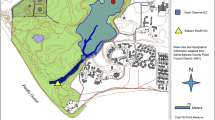Abstract
The Waange-Sewa basin with its extensive floodplains forms the major part of the Sherbro estuary. It is identified as one of the foremost areas for agriculture and fisheries in the southern part of Sierra Leone. Preliminary analysis on basic physico-chemistry and fish fauna of the rivers and lakes within the Waange-Sewa basin were made for the dry season and rainy season of 1983. Physico-chemical variables were used to estimate potential fish production for its river, floodplains, and lakes.
Similar content being viewed by others

References
Andah, B. W., 1981. Processes of coastal evolution in West Africa during the Quaternary. In B. K. Swarty, Jr. & R. E. Dunnett (eds), West African Culture Dynamics. Mouton, The Hague: 17–36.
Blache, J., 1964. Les poissons du Bassin de Tchad et du Bassin adjacent du Mayo Kebbi. Etude systématique et biologique. Mém. O.R.S.T.O.M., 483 pp.
FAO/UN, 1978. Symposium on river and floodplain fisheries in Africa-Bujumbura, Burundi, 21–23 November 1977.
FAO/UN, 1979. Role of fishery technology in the management and development of freshwater fisheries in Africa. Rome. C.I.F.A. Tech. Pap. No. 6.
Fryer, G. & T. D. Iles, 1972. The cichlid fishes of the Great Lakes of Africa: Their biology and evolution. Oliver & Boyd, Edinburgh, 641 pp.
Henderson, H. F. & R. L. Welcomme, 1974. The relationship of yield to morpho-edaphic index and numbers of fishermen in African inland fisheries. FAO/UN. Rome. C.I.F.A. Occ. Pap. No. 1, 19 pp.
McIntoch, R. & S. McIntoch, 1983. Current direction in West African prehistory. Ann. Rev. Anthropol. 12: 215–258.
Moyle, J. B., 1956. Relationship between chemistry of Minnesota surface waters and wildlife management. J. Wildl. Mgmt. 20: 303–323.
Petr, T., 1968. The establishment of lacustrine fish population in the Volta Lake in Ghana during 1964–1966. Bull. I.F.A.N., sér. A. 30: 257–269.
Petr, T., 1973. A pre-impoundment limnological study, with special emphasis on fishes of the Great Ruaha River (Tanzania) and some of its tributaries (River Yovi and the Little Ruaha) in and around the proposed impoundment area. Report for TANESCO, Tanzania, SWECO, Stockholm, 104 pp.
Rawson, D. S., 1952. Mean depth and fish production of large lakes. Ecology 33: 513–521.
Rawson, D. S., 1955. Morphometry as a dominant factor in the productivity of large lakes. Verh. int. Ver. Limnol. 12: 164–175.
Ryder, R. A., 1965. Method for estimating the potential fish production of north temperate lakes. Trans. am. Fish. Soc. 94: 214–218.
Sioli, H., 1975. Tropical river: The Amazon. In B. A. Whitton (ed.), River Ecology. Blackwell Scientific Publications, Oxford: 461–488.
Sutton, J. E. G., 1974. The aquatic civilization of Middle Africa. J. afr. History. Cambridge University Press, Cambridge.
Author information
Authors and Affiliations
Rights and permissions
About this article
Cite this article
Iscandri, N.B. Biological observations on freshwater systems adjacent to the coast of Sierra Leone. Hydrobiologia 208, 63–73 (1990). https://doi.org/10.1007/BF00008444
Issue Date:
DOI: https://doi.org/10.1007/BF00008444



